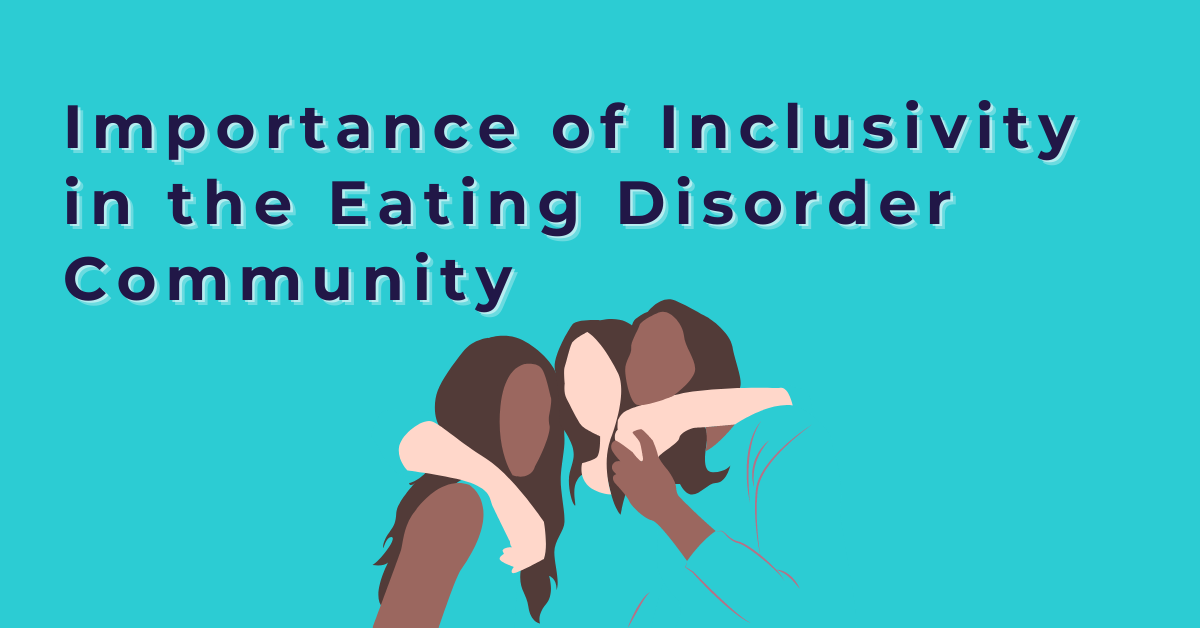February 23rd, 2022

Eating disorders are the deadliest of all mental illnesses, with the recent exception of the rise in opioid overdoses. In the United States, approximately 30 million individuals have lived with an eating disorder, and many others go undiagnosed or engage in disordered eating symptoms.
When people hear about eating disorders, they typically think of young, white, cisgender females struggling with these disorders. However, the mental health field has recently begun to acknowledge that eating disorders do not discriminate. People of all ages, sexes, gender identities, racial identities, ethnic identities, and body types experience eating disorders.
This week the National Eating Disorder Association (NEDA) celebrates the annual National Eating Disorder Awareness Week and this year the theme is “See the Change, Be the Change”.
With this theme, we’re encouraged to “See the Change” by recognizing changes in the eating disorders field, and “Be The Change” through advocacy, awareness, and community involvement.
To “See the Change”, it is important to first recognize the change in eating disorder research, in the past two decades in particular. Eating disorders were once thought to be “culture-bound syndromes,” which individuals of racial and ethnic minority groups were relatively immune to. However, research and clinical settings have since recognized that eating disorders impact people of all races and ethnicities at a similar rate.
Many studies have found that the prevalence of eating disorders is similar in white women and women of color. Research also shows that binge eating is experienced at a similar rate in white women as it is in African American and Latina women. Furthermore, body dissatisfaction and a focus on thinness are seen at similar or even higher rates in Asian American women as they are in white women.

Despite all genders, ethnicities, and cultures being affected at similar rates, stereotypes still exist around what eating disorders look like. The stereotype that eating disorders only affect young, thin, white girls and women, has caused minorities to be overlooked in the development of treatment and research on eating disorders. Cultural differences in the experience and presentation of eating disorder symptoms have led many minorities to go undiagnosed, as a result of this false stereotype.
For instance, being thin is the main driver behind eating disorder symptomology in many. This is a result of the “Thin Ideal”, which is the cultural ideal that being thin equates to attractiveness. However, research has found that for women of color, being thin is not usually the main focus or drive behind disordered eating behaviors. Instead, factors like acculturation, racial identity, and ethnic identity influence their eating behaviors.
In recent years, we've seen greater acknowledgment of eating disorders in cisgender men, older adults, various body sizes, people of color, and the LGBTQ+ community, and this is just the beginning. Research has shown that LGBTQ+ individuals are often at a higher risk of developing an eating disorder, as early as twelve years old, compared to heterosexual individuals.

Diverse representation in research and treatment is an important step in breaking down barriers that prevent minorities from receiving treatment for eating disorders. NEDA did a great job of raising awareness of the impact eating disorders have on people from underrepresented communities and the systemic biases they often face, with their theme last year, “Every Body Has a Seat at the Table”.
Events and meetings like these are what we need to see change. We need to have open discussions with leaders and the community about diversity and inclusion within our field.
One major barrier most individuals seeking treatment for an eating disorder continue to face is the lack of insurance coverage for treatment at various levels of care. With hospitalizations and residential treatment costing tens of thousands of dollars, many Americans are unable to receive appropriate treatment, and this barrier impedes their ability to receive necessary treatment.

The change began with the acknowledgment and inclusion of diverse representation in the research base over the last decade, but the work does not stop there. Whether you are a clinician, researcher, or someone struggling with an eating disorder yourself, here are a few ways you can “Be the Change” in the movement for more inclusive research and treatment for eating disorders.
Read more about what eating disorders are and the changes in the research and treatment of them so you can participate in helpful conversations about the ever-evolving eating disorder field. Once you have a basic understanding of eating disorders, it can be helpful to learn more about how they are experienced by diverse groups.
Education increases cultural competence, which is especially important for clinicians. Cultural competence is the ability to understand, appreciate, and interact with people from cultures or belief systems different from one’s own. This allows us to not only better understand and appreciate their culture, but also to look at eating disorders in a new way, and adapt our assessment and treatment procedures accordingly.
By providing culturally competent care, we are not only helping the client feel seen and understood but also providing care that will be most optimal in their recovery journey.
Start by volunteering for a non-profit eating disorder association like NEDA. As a volunteer for NEDA, you will help raise awareness for eating disorders, host fundraising events for eating disorder research, and increase access to resources in underrepresented groups. You can join NEDA walks, NEDA Con, and participate in NEDAwareness week.
Get involved in legislative advocacy to increase access to care and research on eating disorder treatment. You can do so by donating or joining a group like the Eating Disorders Coalition.
The research on Eating Disorders has progressed in terms of a greater pool of diversity, but there is still a long way to go.
If you are living with an eating disorder or struggling with disordered eating symptoms, advocate for yourself today by seeking treatment. If you’ve already made that first step but feel aspects of your identity are not being incorporated into your treatment, think about how to share this with your provider. Then, the next time you see them discuss incorporating these aspects into your treatment and recovery journey.
If you are comfortable doing so, share your story with others. Nothing is more powerful than hearing about the struggles and triumphs of eating disorder recovery from people of all backgrounds who have experienced it first-hand. This helps establish a sense of community and reminds us that we are in this together.
Written By: Dr. Nicole Ortiz, PhD
At Clarity Clinic, we have highly trained staff who specialize in therapy and psychiatry services. To learn more about how we can support your mental health, call Clarity Clinic on (312) 815-9660 or schedule an appointment today.
Our Services
Virtual/Online CarePHP and IOPAdult PsychiatryChild & Adolescent PsychiatryAdult TherapyChild & Adolescent TherapyCouples CounselingFamily TherapyGroup TherapyPsychological TestingTranscranial Magnetic Stimulation (TMS)